A Living Earth Called “Gaia”
Air Date: Week of September 3, 2021
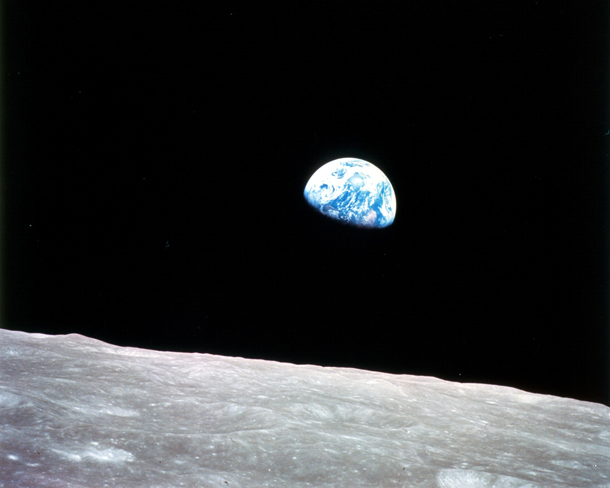
Earthrise is the image of planet Earth taken from the Apollo spacecraft during the first manned mission to the moon, led by NASA in 1968. This event has continuously sparked interest in the beauty of the earth, and the possibilities brought forth by science. (Photo: NASA, www.earthday.org, Public Domain)
Next, Host Steve Curwood and the Living on Earth team explore Earth as a complex and self-sustaining organism called Gaia. Over billions of years life has interacted with the air, water and rocks of this planet to keep life in the sweet spots for temperature and resource supplies. With the help of scientists, deep ecologists, children, an astronaut and more, we explore our place on this living planet.
Transcript
CURWOOD: It’s Living on Earth, I’m Steve Curwood
[MUSIC: Keith Jarrett Trio “Poinciana – Live At Palais Des Congres, Paris / 1999” on Whisper Not, ECM Records GmbH]
CURWOOD: One of the most fascinating aspects of science is the way its knowledge base is always changing, and new discoveries can come almost, if not entirely, by accident. Indeed, so many discoveries like radioactivity and antibiotics came when researchers were looking for something else in their laboratories and then, fortunately, had the good sense to pay attention when they got unexpected results. And some of that good sense comes from the humility of knowing that there are so many amazing things that accepted science still doesn’t understand. Consider, for example, that few of us would dispute the existence of love, though hopefully all of us have experienced it. But science cannot explain precisely what love is or even the exact process that creates, shares and enjoys love. Some day we may be able to explain in more scientific terms what is now the mystery of love, as unromantic that might sound, much as after millennia of observing birds fly, humans finally figured out the physics of how the birds do it so we could make wings to carry ourselves. When it comes to Earth’s climate there are still huge gaps in our knowledge of how the Earth stays neither too hot nor too cold to support life. The big unanswered questions are why and exactly how. We do understand which molecules reflect the sun’s heat and which ones can trap it. But modern humans have never lived through a major shift in the climate, so we can only speculate what might happen if the Goldilocks range of temperatures we need to survive are ever knocked out of whack. Right now, we are guessing that a more than a 2-degree centigrade rise in average global surface temperatures over preindustrial levels will literally start toasting civilization, and the climate disruption we already can see and feel comes from little more than a one-degree rise. Our guesses come from models run on supercomputers, but among their weaknesses they are poor at modeling clouds, and water vapor is our most prevalent greenhouse gas. But we humans do have the power to observe, and thanks to the observations of a genius named James Lovelock there is a hypothesis that could unlock a whole systems approach to protecting the amazing life forms that have arisen on Earth. Thanks to the suggestion of a friend, James Lovelock called it the Gaia Hypotheses, after the Greek Goddess who symbolizes Earth. Simply put, the Gaia hypothesis says the whole Earth system acts like it is alive and uses mechanisms that living creatures use to stay alive by constantly regulating temperature, chemical and physical inputs and outputs, and adapting through evolution. James Lovelock ,who turned 101 in 2021 came up with his accidental discovery when NASA asked him back in the 1960s to see if his inventions could detect life on the other planets by looking at their atmospheres.
[MUSIC: The Crusaders “So Far Away (1974 The Roxy)” on Scratch, The Verve Music Group]
CURWOOD: Venus, our nearest neighbor at 25 million miles closer to the Sun than Earth, is literally a hot mess with steady surface temperatures of nearly 900 degrees Fahrenheit, and an atmosphere of mostly carbon dioxide laced with bits of sulfur droplets. Not hospitable for life forms we know. Mars, 100 million miles further from the Sun than Earth is a bit less hostile to life with days of searing heat and nights of deep cold like our moon, but also with an atmosphere that is overwhelmingly made up of carbon dioxide with just tiny traces of oxygen. His genius kicked in when he realized the bigger question was not if there was life on those other planets, but why there was life on here on Earth. All three planets have histories of strong volcanos that spew out huge amounts of carbon dioxide. Left on its own the CO2 -belching volcanos on Earth would have led to a hothouse or desert over time. But something has kept carbon dioxide levels in a sweet spot, just four hundredths of a percent of the Earth’s atmosphere, enough to keep it warm but not too warm for life while the oxygen needed for animals is in great abundance. And that something is life itself. About a billion years after the Earth was formed, air, rocks and microbes likely came together and photosynthesis evolved. Photosynthesis is how plants, algae and other organisms convert sunlight into chemical energy and break down CO2 into its elements, carbon and oxygen. So, over millions of years plants and algae sequestered in their cells all that carbon from volcanos, and when buried in the ground or under the sea some of it eventually became coal and oil. Four times in Earth’s geologic history giant eruptions of volcanoes belched out so much CO2 they set off mass extinctions. There was also the mass extinction linked to an asteroid strike that likely shut down a lot of photosynthesis and allowed CO2 to rise. In every case Earth had to start sequestering carbon again as life evolved to adapt to new conditions. So, when we drill and dig up fossil fuels today, we are upsetting a balance the Earth works hard to keep. But if we keep those fossil fuels in the ground, we help support the living planet and all the life that we know about in the universe.
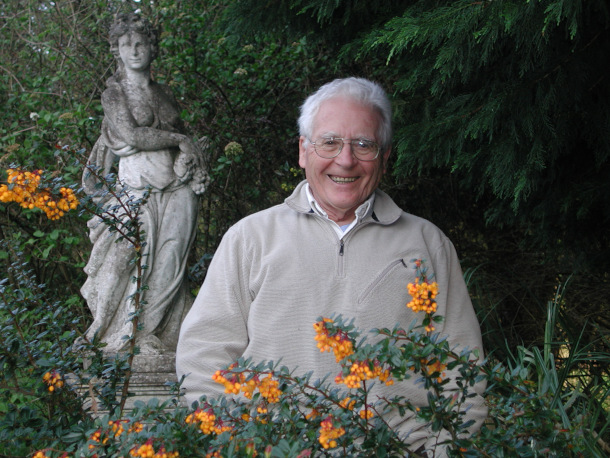
James Lovelock, shown here in 2005, is an English independent scientist who first proposed the Gaia hypothesis. (Photo: Bruno Comby, The Association of Environmentalists For Nuclear Energy, Wikimedia Commons, CC BY-SA 1.0)
[MUSIC: Xavier Rudd “Follow The Sun” on Spirit Bird, Salt.X Records Ltd]
CURWOOD: Many scientists have helped advance the Gaia hypothesis over time which now includes seeing the whole planet including life, atmosphere, water, and rocks as a single complex organism. Back in 1970’s the late UMass Amherst Professor Lynn Margulis co-published journal articles about the Gaia with James Lovelock. Her insights about symbiotic evolution rather than brutal competition suggested some mechanisms for Gaia’s self-regulation. One of the most public voices now on the Gaia hypothesis is a former student of James Lovelock, Stephan Harding. He is now a Deep Ecology Research Fellow at Schumacher College in England. In sum, he says, every living plant and animal on Earth interacts with the non-living rocks, atmosphere and water to make the planet an independent living organism.
HARDING: The scientific idea is that when they start interacting with each other, these four components, something extraordinary emerges out of those interactions, which you couldn't have known in advance. It's called an emergent property. It says the science is the ability of the whole of all four of them working together, all of them, life, atmosphere, rocks and water working together to keep the surface conditions on the planet suitable, or within the limits that life can tolerate. You see, life has a very important role here. Life is intimately involved in regulating the temperature, the acidity of the planet, the distribution of key elements. And so, the idea suggests that the earth is one great living organism.
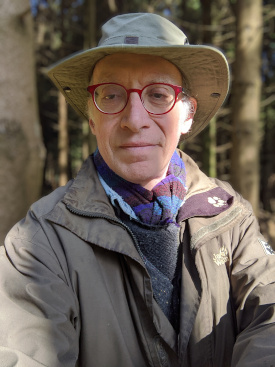
Stephan Harding is an ecologist author, and Head of Holistic Science at Schumacher College. (Photo: Courtesy of Stephan Harding)
CURWOOD: One living organism. And as thinking about Gaia has evolved more credence is given to the notion that not just biologically active beings but also the so-called inanimate things like rocks and water can also support life. Observations reveal countless examples of the ways in which life in its many forms regulate the planet. Again, Stephan Harding.
HARDING: Well, basically, we now know that many kinds of organisms, including marine algae, and forests, like rain forest, they emit chemicals that seed clouds. And those clouds are dense and white and they cool the earth. And this is happening over the rain forests, and over parts of the ocean. So just think of that living beings are actually helping to cool the surface of the planet. I mean that's amazing . There’s more, there’s also we're pretty sure we know how Gaia has regulated her temperature, over geological time, despite volcanoes continually emitting carbon dioxide into the atmosphere, which of course, as we know, is a greenhouse gas. And simultaneously, the sun getting brighter and brighter and brighter throughout geological time. So that now it's about 30% brighter than it was when life began maybe 4,000 million years ago or so. So, these two combined, you know, the increasing co2 in the atmosphere, and the increasing brightness of the sun is a recipe for an absolute disaster for life. eventually the planet will get so hot. The surface gets so hot, all the water would evaporate, boil off, like in a kettle. It's called a runaway greenhouse. That's what happened on Venus. But it didn't happen on Earth, because of life because of life interact, holding the water down, capturing the hydrogen as it was trying to flee.
CURWOOD: Many of the very chemicals we take for granted for life on earth are themselves a result of life on earth, including the oxygen from photosynthesizing, notes Martin Ogle a scientist and educator with Entrepreneurial Earth.
OGLE: If it weren't for life, that some huge number of the minerals on Earth would not exist. And so, if you just think of oxides, for instance, as many of the minerals of earth that they wouldn't exist, if it were not for life.
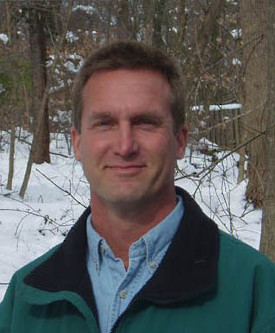
Martin Ogle is the founder of Entrepreneurial Earth and formerly served as Chief Naturalist for the Northern Virginia Regional Park Authority for 27 years. (Photo: Courtesy of Entrepreneurial Earth)
CURWOOD: And by the way, a most valuable oxide is aluminum oxide in the form of the gem ruby.
Gaia as a living system is complex, and not fully understood. But just as we can observe and enjoy love without understanding its exact scientific mechanisms and we watched birds for millennia before we figured out the mechanics of flight, our observations can tell us a lot about Gaia. In fact, long before modern science emerged, traditional and aboriginal societies already saw the Earth as alive. Joe Bruchac is a Native American storyteller and tells the story of the Shinnecock tribe from Long Island.
BRUCHAC: It is said that in the 17th century, a group of missionaries visited there, and they gathered together a group of Native people. And assuming these people knew nothing about God or creation but had very unsophisticated ideas. They said, We wish to teach you about God, but do you have any idea of God or the creation? And then people said, oh, yes, we do. And let us show you, they drew a circle on the ground, and the earth, then they drew a very small circle in the center of that. And they said, this is the eye of creation. And we human beings are that small dot, the middle, surrounded by all the creation, by the great mystery, we are always in the eye of the creation, we're always seen by the great mystery. And the missionaries didn't quite know what to say in response to that.
CURWOOD: Today some people dismiss the Gaia hypothesis and the role of rocks and water in life as a pseudo intellectual exercise to put a more acceptable face on animism beliefs of aboriginal societies. But even a child in modern America can feel and express a deep connection to the earth in ways many of us lose or feel awkward talking about as adults. Living on Earth’s Bobby Bascomb recently read Marc Majewski’s book for children, Does Earth Feel with some children in her life. The book poses 14 simple but profound questions for anyone to consider, including does the Earth feel?
Joe Bruchac is Nulhegan Abenaki elder, a storyteller and author of more than 120 books for children and adults. (Photo: Courtesy of Joe Bruchac)
ALL KIDS: Yes!
BASCOMB: Does Earth feel curious?
VERONICA: Yeah, it's curious because there's lots of fluttering animals like butterflies.
BASCOMB: Yeah. And then the question here is, does the earth feel hurt?
ALL KIDS: Yes. Yes.
BASCOMB: What? Why?
VERONICA: People aren't being as nice to it.
BASCOMB: What do they do that's not nice?
VERONICA: They chop down trees and shoot animals for fun. Because people put oil in the water.
BASCOMB: How do you think that hurts the earth?
SAGE: Because it hurts animals in the earth.
BASCOMB: Do you think when the animals are hurt the whole earth feels hurt?
SAGE: Yes!
CURWOOD: Stephan Harding says we are all born with an intrinsic understanding of Gaia.
HARDING: So it's, it's just our natural humanity to feel the earth is alive. And as a mother built into us, you could say, Oh, that's good. That's natural selection. those groups that felt the earth as a mother and treated her well survived. And those that didn't, and treated her like, like we treat her didn't survive. Quite right. Natural Selection. In a way, well I don’t know you can imagine a scenario like that. Modernity is headed for an extinction because of the way we relate. You don't relate to Gaia with our aboriginality we relate to her through our greed. You know, and our desire for more stuff and more money and more prestige and Competitive urges are just over exaggerated. So that council like that will be will go extinct.
CURWOOD: If modern humans don’t change our ways to find harmony with the earth Gaia will do it for us.
HARDING: That's a classic Gaian feedback. we've, we've pushed nature back, we’ve destroyed her to such an extent that there have to be very powerful feedbacks to control this species, the species of modernity. I won't say humans, because humans are wonderful, it’s modernity that's the problem. I've come to that conclusion, modernity, this modern way of life. It's a big problem. And it's evoking these feedbacks from Gaia. The coronavirus is just the start. I mean, if we don't do anything about greenhouse gases and the destruction of biodiversity, which help us control greenhouse gases, amongst other things, you know, we haven't got we haven't got much hope really? I mean, really? Not in the long term. That's the science.
CURWOOD: Perhaps the most powerful observations of Gaia come from people who have seen the Earth from outer space, including retired NASA astronaut Ron Garan, who flew in the shuttle and got to take a spacewalk.
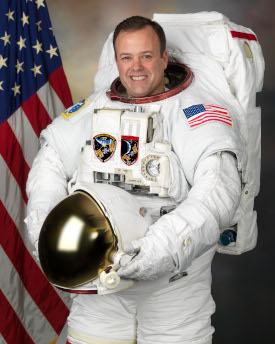
Ron Garan is a retired NASA astronaut who spent 177 days in space, with 27 hours spent on EVAs, or extravehicular activities. (Photo: Robert Markowitz, NASA, Wikimedia Commons, Public Domain)
GARAN: As the payload bay doors opened, blue light was starting to seep in through the opening. And these massive payload bay doors, that was Earth shine, you know, reflected light from the Earth's surface. And as the payload base doors continue to open, eventually the horizon came into view. And when the horizon came into view, I was immediately thrust out of this disappoint of just being in an aircraft looking at the planet in high altitude to seeing the planet hanging in the blackness of space. A planet that all of the primates where no longer on. And so there was this feeling of detachment like I was physically detached from the earth, and that that feeling of detachment, I think, was immediately followed by something I can't really fully explain to this day, but that detachment, I think, led to this feeling of a deep interconnection with everyone and everything on the planet. It was as if for the first time in my life, I stepped outside the frame of the masterpiece, you know, we're looking at this beautiful, breathtaking, planet turning blue, you know, 240 miles below us was, was looking at it at a masterpiece. So, looking at this, this work of art, this, this beautiful thing, hanging in the blackness of space from the outside in. And I had obviously never seen the earth from that vantage point. And I thought about that, you know, when we when we look at, you know, go to the rim of the Grand Canyon, look at the Grand Canyon, when we sit on a beach at sunset and look at a beautiful sunset, gravity is pushing us into that scene, we're inside the frame of the masterpiece, we're part of that, of that painting, if you will. But for the first time in my life, I was seeing this exquisite beauty from the outside and, and somehow that outsider perspective, what I call the orbital perspective compelled me to feel deeply interconnected with everybody and everything on the planet.
CURWOOD: Ron Garan says the name Gaia is fine but he balks at the word hypothesis.
GARAN: I don't think it's a hypothesis. I think it's obvious I am seeing the planet from the vantage, that vantage point of space makes it obvious that we're looking at a living breathing organism, a multi celled organism, an organism that has different, you know, aspects of it, that based on the various, you know, multi varied species of life that exists upon the surface and below the surface of earth, and in the atmosphere of earth. And all of those different species, different individual animals, and plants are all part of an implicit wholeness, that is the planet itself. It's all not only interconnected, it's deeply, deeply interdependent.
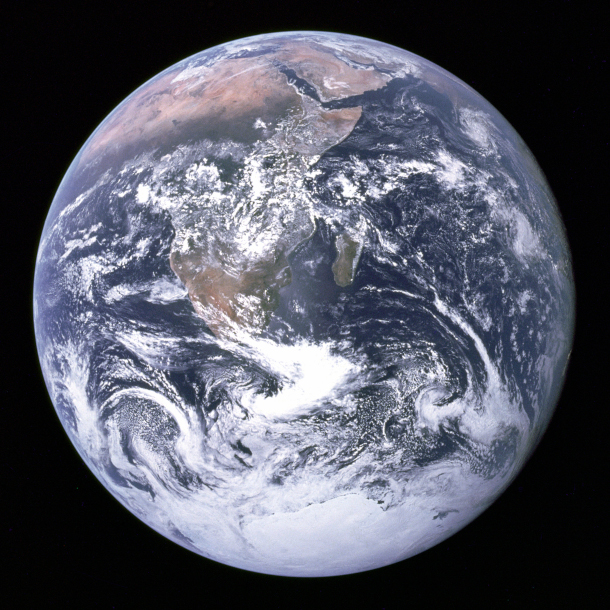
The Blue Marble, a photograph of Earth taken by the crew of Apollo 17 in 1972. (Photo: Apollo 17 Crew, NASA, Wikimedia Commons, Public Domain)
CURWOOD: One doesn’t have to go to outer space to feel Gaia. It can as simple as taking a moment outdoors to be aware of the beauty around you and feel yourself drawn into the presence of the Earth. And by the way, some skeptics say Gaia doesn’t qualify as a living being because things that are alive reproduce. Well, the simplest way organisms reproduce is by division. And some already envision a colony of humans and other Earth life forms on Mars. Indeed Perseverance, the most recent NASA expedition to Mars ,has an experimental machine called Moxie that mimics photosynthesis to produce oxygen. So, the gestation may be taking billions of years, but Gaia is in fact taking the steps to reproduce herself, which would truly make her Mother Earth.
Links
Watch James Lovelock explain the Gaia hypothesis for Naked Science in 2007
Living on Earth wants to hear from you!
Living on Earth
62 Calef Highway, Suite 212
Lee, NH 03861
Telephone: 617-287-4121
E-mail: comments@loe.org
Newsletter [Click here]
Donate to Living on Earth!
Living on Earth is an independent media program and relies entirely on contributions from listeners and institutions supporting public service. Please donate now to preserve an independent environmental voice.
NewsletterLiving on Earth offers a weekly delivery of the show's rundown to your mailbox. Sign up for our newsletter today!
 Sailors For The Sea: Be the change you want to sea.
Sailors For The Sea: Be the change you want to sea.
 The Grantham Foundation for the Protection of the Environment: Committed to protecting and improving the health of the global environment.
The Grantham Foundation for the Protection of the Environment: Committed to protecting and improving the health of the global environment.
 Contribute to Living on Earth and receive, as our gift to you, an archival print of one of Mark Seth Lender's extraordinary wildlife photographs. Follow the link to see Mark's current collection of photographs.
Contribute to Living on Earth and receive, as our gift to you, an archival print of one of Mark Seth Lender's extraordinary wildlife photographs. Follow the link to see Mark's current collection of photographs.
 Buy a signed copy of Mark Seth Lender's book Smeagull the Seagull & support Living on Earth
Buy a signed copy of Mark Seth Lender's book Smeagull the Seagull & support Living on Earth

